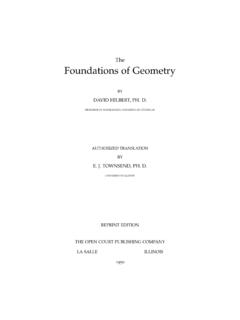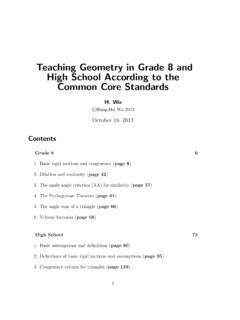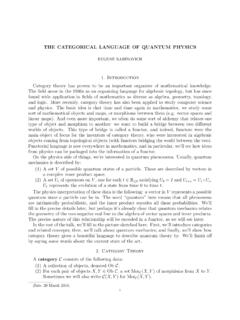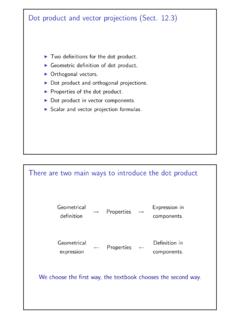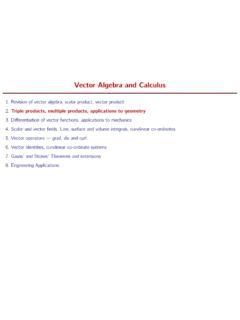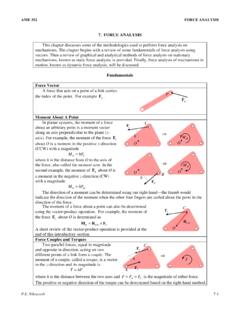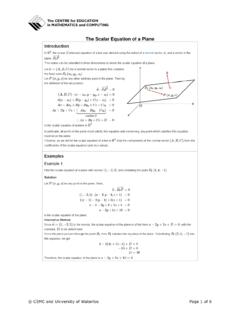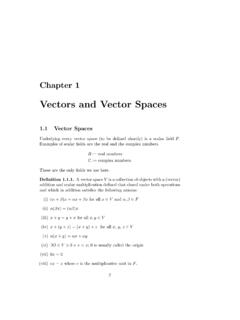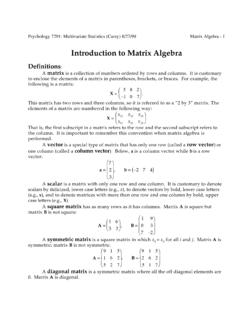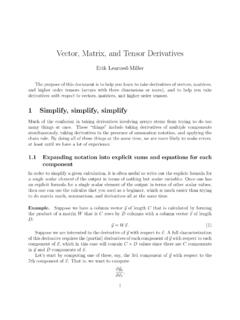Transcription of Math 110: Worksheet 1 Solutions
1 Math 110: Worksheet 1 SolutionsAugust 30 Thursday Aug. 241. Determine whether or not the following sets form vector spaces over the given fields.(a) The setVof all matrices of the form(1ab1)wherea, b R, overRwith standardaddition and scalar thatVis not closed under addition: fora, b, c, d R, we have(1ab1)and(1cd1)but(1ab1)+(1cd1)=(2a+ cb+d2)/ conclude thatVis not a vector space with the given operations.(b) The setVof all matrices of the form(1ab1)wherea, b R, overRwith addition and scalar multiplication defined by(1ab1) (1cd1)=(1a+cb+d1), k (1ab1)=(1kakb1).We claim thatVis indeed a vector space with the given operations. Note firstthatVis closed under the addtion and scalar multiplication operations: for(1ab1),(1cd1) Vandk R, we have(1ab1) (1cd1)=(1a+cb+d1) Vandk (1ab1)=(1kakb1) 1:Observe that(1ab1) (1cd1)=(1a+cb+d1)( defn. of addition)=(1c+ad+b1)( comm. of addition inR)=(1cd1) (1ab1)( addition)VS 2:Note that((1ab1) (1cd1)) (1ef1)=(1a+cb+d1) (1ef1)( defn.)
2 Of addition)=(1(a+c) +e(b+d) +f1)( addition again)=(1a+ (c+e)b+ (d+f)1)( add. assoc. inR)=(1ab1) (1c+ed+f1)( addition)=(1ab1) ((1cd1) (1ef1))( addition)VS 3:The matrix(1 00 1) Vand acts as the zero vector:(1ab1) (1 00 1)=(1ab1)VS 4:Given any(1ab1) V, its additive inverse is(1 a b1)as(1ab1) (1 a b1)=(1 00 1)VS 5:Observe that1 (1ab1)=(1ab1).VS 6:Letk, l R, we have(kl) (1ab1)=(1(kl)a(kl)b1)( defn. of scalar mult)=(1k(la)k(lb)1)( mult. assoc. inR)=k (1lalb1)( scalar mult.)=k (l (1ab1))( scalar mult.)2VS 7:We havek ((1ab1) (1cd1))=k (1a+cb+d1)( addition.)=(1k(a+c)k(b+d)1)( scalar mult.)=(1ka+kckb+kd1)( dist. inR)=(1kakb1) (1kckd1)( addition)=(k (1ab1)) (k (1cd1))( scalar mult.)VS 8:We have(k+l) (1ab1)=(1(k+l)a(k+l)b1)( scalar mult.)=(1ka+lakb+lb1)( dist. inR)=(1kakb1) (1lalb1)( addition.)=(k (1ab1)) (l (1ab1))( scalar mult.)(c) The setVof all positive real numbers overRwith addition and scalar multi-plication defined byx y=xy, a x= show thatVis indeed a vector space with the given operations.
3 Note firstthat ifx, y Vanda R, we havex y=xy V, a x=xa VsoVis closed under addition and scalar 1:We havex y=xy( addition)=yx( mult. comm. inR)=y x( addition)VS 2:Note that(x y) z= (xy) z( addition)= (xy)z( addition)=x(yz)( mult. assoc. inR)=x (yz)( addition)=x (y z)( addition)3VS 3:Observe that 1 Vand1 x= 1x= 4:For anyx V, note thatx 1 Vso thatx x 1=xx 1= 5:Note that1 x=x1= 6:Leta, b R. We then have(ab) x=xab( scalar mult.)= (xb)a( exponents inR)=a (xb)( scalar mult.)=a (b x)( scalar mult.)VS 7:Note thata (x y) =a (xy)( addition)= (xy)a( scalar mult.)=xaya( exponents inR)= (xa) (ya)( scalar mult.)= (a x) (a y)( addition)VS 8:We have(a+b) x=xa+b( scalar mult.)=xaxb( exponents inR)= (xa) (xb)( addition)= (a x) (b x)( scalar mult.)(d) The setVof Solutions of the differential equationf (t) 4f(t) =t, t RoverRwith standard addition and scalar thatVis not closed under addition: iff1, f2 V, then for allt Rf 1(t) 4f1(t) =t, f 2(t) 4f2(t) =tso that(f1+f2) (t) 4(f1+f2)(t) = (f 1(t) 4f1(t)) + (f 2(t) 4f2(t)) = 2t6 conclude thatVis not a vector space with the given (e) The setVof 2 2 invertible matrices with real entries overRwith standardaddition and scalar thatVis not closed under addition: we have(1 00 1),(100 1) Vbut(1 00 1)+(100 1)=(2 00 0)is not invertible.
4 We conclude thatVis not a vector space with the given By definition, every fieldFhas amultiplicative identity, an elementesuch thate x=xfor every elementx F. What is the multiplicative identity forR? Prove that themultiplicative identity is unique for any given multiplicative identity forRis the number 1 as 1 x=xfor allx show that the identity is unique, leteande be two identities. Consider then theproducte e . By thinking ofeas an identity, we havee e =e . Likewise, thinking ofe as an identity leads toe e =eso thate=e . Thus, the identity is Aug. 293. Prove that the set of matrices with zero trace form a subspace ofMn n(F). Does thesame hold for matrices with zero determinant?LetTbe the set of matrices with zero trace. AsMn n(F) is a vector space overFandTis its subset, we merely need to check three properties: the matrixZconsisting only of zero entries evidently has zero trace soZ T.
5 LetA, B T; it follows then that tr(A) = tr(B) = 0. Note then thattr(A+B) =n i=1(A+B)ii=n i=1 Aii+n i=1 Bii= tr(A) + tr(B) = 0. letA Tandk F; we have tr(A) = 0 so thattr(kA) =n i=1(kA)ii=kn i=1 Aii=ktr(A) = conclude thatTis a subspace ofMn n(F).The same cannot be said however about the set of matrices with zero determinant asit is not closed under addition. As an example, letAbe the diagonal matrix withA11= 0 andAii= 1 fori= 2, .. , nand letBconsist only of zeros except forB11= , det(A) = det(B) = 0 but det(A+B) = 16= LetB(R) be the set of allboundedfunctions onR(A functionfis bounded if thereexistsMsuch that|f(x)| Mfor allx. Thus sin(x) is bounded onRbutexis not).Prove thatB(R) is a subspace ofF(R,R), the set of all functions (R,R) is a vector space andB(R) is its subset, we just need to check the followingthree properties: the functionz 0 is clearly bounded (as|z(x)|= 0<1 for allx) soz R.
6 Letf, g B(R). Then there existM, Nsuch that|f(x)| Mand|g(x)| Nforallx R. Note then that, by the triangle inequality|(f+g)(x)|=|f(x) +g(x)| |f(x)|+|g(x)| M+Nfor allx R; thus, (f+g) is bounded and hence inB(R). letf B(R) anda R. Observe then that for allx R|(af)(x)|=|af(x)|=|a||f(x)| |a|Msoaf B(R).We conclude thatB(R) is a subspace ofF(R,R).5. LetW1andW2be subspaces of a vector spaceV. Prove thatW1+W2=W2if andonly ifW1is a subspace first thatW1is a subspace ofW2. Lett W1+W2; there then existw1 W1andw2 W2such thatt=w1+w2. AsW1is a subspace ofW2, it follows thatw1 W2as well and hencet=w1+w2 W2so thatW1+W2 W2. As we also haveW2 W1+W2, we conclude thatW1+W2= , suppose thatW1+W2=W2; we want to show thatW1is a subspace ofW2. Letw1 W1andw2 W2; then,w1+w2 W1+W2. AsW1+W2=W2, thereexists somet W2such thatw1+w2=t w1=t+ ( w2) conclude thatW1 W2and, in particular, thatW1is a subspace Letv1= (0,1) andv2= (1,1) and defineW1={tv1:t R}andW2={tv2:t R}.
7 Also, letV=R2overRwith standard operations.(a) Show thatW1andW2are subspaces subsets ofVwhich itself is a vector space, we just need tocheck the following three properties: (we treat both the spaces at the same time) 0 Wiby settingt= 0 in the definitions. letx,y Wi. There then existt, s Rsuch thatx=tviandy=svisothatx+y=tvi+svi= (t+s)vi letx Wianda R. Note then thatax=a(tvi) = (at)vi conclude that bothW1andW2are subspaces ofV.(b) Show thatV=W1 need to show that (i)W1 W2={0}and (ii)W1+W2=V. For (i), notethat ifu W1 W2, then for somet, s R, we haveu=tv1andu=sv2so thattv1=sv2 (0, t) = (s, s).It follows thats= 0 t= 0 soumust be the zero (ii), letx= (a, b) R. We want show thatx=w1+w2for somew1 W1andw2 W2. Note that settingw1= (0, b a) andw2= (a, a) accomplishesthis aswi Wifori= 1,2 andw1+w2= (0, b a) + (a, a) = (a, b) = both (i) and (ii) hold, we conclude thatV=W1 LetEandOdenote respectively the subsets consisting of all the even and odd functionsinV:=F(R,R).
8 In the homework, you are supposed to show that bothEandOaresubspaces ofV. Assuming that, prove thatV=E in the previous problem, we just need to show that (i)E O={0}and (ii)E+O=V. For (i), letf E O. Then, for anyx R, we havef( x) =f(x) andf( x) = f(x) so thatf(x) = f(x) f(x) = 0 f (ii), letf V. We need to show thatf=g+hwhereg Eandh O. Definefor allx Rg(x) =f(x) +f( x)2, h(x) =f(x) f( x) then thatg(x) +h(x) =f(x) for allx. Furthermore, for anyx R, we haveg( x) =f( x) +f(x)2=g(x)h( x) =f( x) f(x)2= h(x).This shows thatg Eandh Oand hence establishes (ii). We conclude thatV=E

